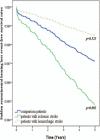Risk of sudden sensorineural hearing loss in stroke patients: A 5-year nationwide investigation of 44,460 patients
- PMID: 27603402
- PMCID: PMC5023925
- DOI: 10.1097/MD.0000000000004841
Risk of sudden sensorineural hearing loss in stroke patients: A 5-year nationwide investigation of 44,460 patients
Erratum in
-
Erratum: Risk of sudden sensorineural hearing loss in stroke patients: A 5-year nationwide investigation of 44,460 patients: Erratum.Medicine (Baltimore). 2017 Feb 17;96(7):e6217. doi: 10.1097/MD.0000000000006217. eCollection 2017 Feb. Medicine (Baltimore). 2017. PMID: 31305750 Free PMC article.
Abstract
Poststroke sudden sensorineural hearing loss (SSNHL) can hinder communication between patients and healthcare professionals, thereby restricting participation in rehabilitation programs and limiting improvements in physical performance. However, the relationship between stroke and SSNHL remains unclear. This study employed a nationwide population-based dataset to investigate the relationship between stroke and SSNHL.The Taiwan Longitudinal Health Insurance Database was used to compile data from 11,115 stroke patients and a comparison cohort of 33,345 matched nonstroke enrollees. Each patient was followed for 5 years to identify new-onset SSNHL. Stratified Cox proportional-hazard regression analysis was used to examine the association of stroke with subsequent SSNHL.Among the 44,460 patients, 66 patients (55,378 person-years) from the stroke cohort and 105 patients (166,586 person-years) from the comparison cohort were diagnosed with SSNHL. The incidence of SSNHL was approximately twice as high among stroke patients than among nonstroke patients (1.19 and 0.63/1000 person-years, respectively). Stroke patients had a 71% increased risk of SSNHL, compared with nonstroke patients (adjusted hazard ratio [HR] 1.71, 95% confidence interval [CI] 1.24-2.36). We also observed a remarkable increase in risk of SSNHL in stroke patients within 1-year of follow-up (adjusted HR 5.65, 95% CI 3.07-10.41) or under steroid therapy during hospitalization (adjusted HR 5.14, 95% CI 2.08-12.75).Patients with stroke had a higher risk of subsequent SSNHL compared with patients without stroke. In particular, stroke patients within 1-year follow-up and those undergoing steroid therapy during hospitalization should be treated with the utmost caution, considering that the risk of SSNHL increases by more than 5-fold.
Conflict of interest statement
The authors have no conflicts of interest to disclose.
Figures


References
-
- Stachler RJ, Chandrasekhar SS, Archer SM, et al. Clinical practice guideline: sudden hearing loss. Otolaryngol Head Neck Surg 2012; 146:S1–35. - PubMed
-
- Saunders JE, Luxford WM, Devgan KK, et al. Sudden hearing loss in acoustic neuroma patients. Otolaryngol Head Neck Surg 1995; 113:23–31. - PubMed
-
- Murray CJ, Lopez AD. Evidence-based health policy: lessons from the Global Burden of Disease Study. Science 1996; 274:740–743. - PubMed
-
- Bamiou DE. Hearing disorders in stroke. Handb Clin Neurol 2015; 129:633–647. - PubMed
-
- Karpa MJ, Gopinath B, Beath K, et al. Associations between hearing impairment and mortality risk in older persons: the Blue Mountains Hearing Study. Ann Epidemiol 2010; 20:452–459. - PubMed
MeSH terms
Substances
LinkOut - more resources
Full Text Sources
Other Literature Sources
Medical

